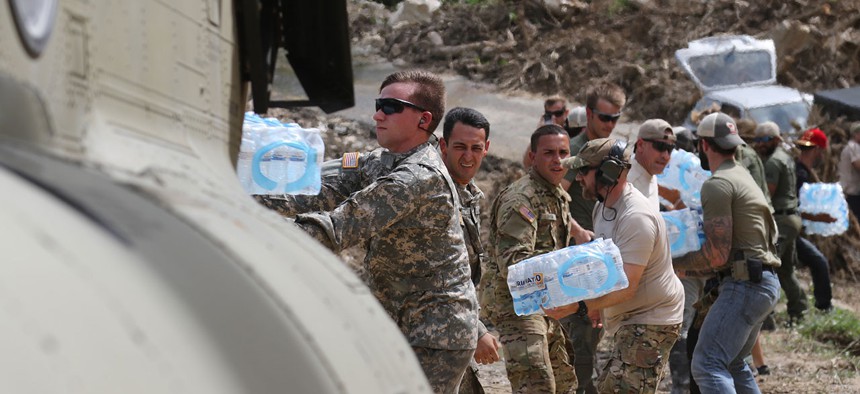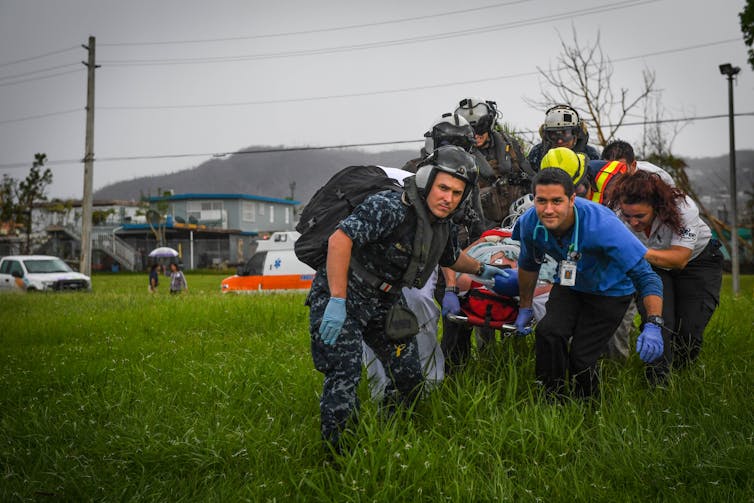
Some 17,000 U.S. troops aided in the Caribbean relief effort after hurricanes Irma and Maria. That’s roughly equivalent to the U.S. military’s humanitarian mission in the Philippines after Typhoon Hiyan in 2013 USDA
Analysis: Military Mission In Puerto Rico After Hurricane Was Better Than Critics Say But Suffered Flaws
Compared to its foreign disaster missions, the U.S. military mobilized slowly after Maria. But in numbers, capacity and logistics coordination, its work in Puerto Rico was on par with other aid efforts.
It’s been over six months since powerful back-to-back storms left “catastrophic” damage in Puerto Rico.
The federal recovery effort in this American territory has been under fire nearly every day since then. Critics note that hurricane relief in Texas and Florida last year was quicker, more robust and more effective.
At the Harvard Humanitarian Initiative, we study the the role of the armed forces in disaster relief and humanitarian emergencies worldwide. So we decided to examine the U.S. military’s deployment to Puerto Rico after hurricanes Irma and Maria.
Limited by posse comitatus
Hurricane Maria hit the island on Sept. 20, 2017. The first soldiers arrived in Puerto Rico eight days later and would stay until mid-November. Eventually, 17,000 troops – including active duty, reserves and National Guard – were deployed to both Puerto Rico and the U.S. Virgin Islands.
Their mission: to conduct search and rescue missions, provide medical care and restore power. Soldiers also delivered food and water to both residents and emergency responders there.
Our first question was why it took the military over a week to get to Puerto Rico. By comparison, U.S. troops were in Haiti two days after its 2010 earthquake.
The answer has to do with an 1878 law called the Posse Comitatus Act, which prohibits American armed forces from performing domestic law enforcement duties. In other words, the U.S. military does not respond to disasters on home soil unless ordered to do so by an act of Congress or for a “humanitarian assistance mission.”
When, in late September, Sen. Marco Rubio, R-Fla., suggested that the military should take over aid distribution in Puerto Rico from the Federal Emergency Management Agency – which was clearly stretched thin by its simultaneous responses to hurricanes Harvey, Irma and Maria – Lt. Gen. Jeffrey S. Buchanan, commander of the U.S. Army North, rejected the idea. His response invoked the limits imposed by the Posse Comitatus Act.
“This is not a dictatorship,” he said. “The military does not take charge of these kinds of operations in the homeland.”
The Department of Defense had sent several FEMA liaisons to the Caribbean before Maria. But, by law, it could not mobilize troops until it was determined that civilian agencies were unable to manage the disaster response. For this reason, the U.S. military can actually respond more quickly to international emergencies than it can at home.
By Sept. 27, FEMA had requested help and the military was preparing to dispatch its first brigade of soldiers to Puerto Rico. Buchanan was named chief of the mission.
Deployments abroad and at home
Though it rarely does disaster relief at home, the U.S. military frequently responds to emergencies abroad. Between 1970 and 2000, American troops provided international humanitarian assistance and disaster relief 366 times, mostly in the Pacific. In the same period, they engaged in combat just 22 times.
We used these foreign deployments as a basis of comparison for evaluating the U.S. military’s Puerto Rico mission. And though some experts have recommended more training for these missions, our prior research has generally found that U.S. troops are quite good at international disaster response.
The U.S. Armed Forces score well on what we’ve identified as critical indicators of military success in a relief mission. They typically deploy quickly, bring a specialized skill set, coordinate well with aid agencies on the ground and plan their arrival and exit appropriately.
We modified these indicators slightly to assess the military’s humanitarian response in Puerto Rico, a domestic emergency. And, beyond the relatively slow mobilization, we found the military performed about as well in the Caribbean as it has abroad.
The deployment of 17,000 troops, 82 aircraft and three combat support hospitals was comparable in size to the U.S. military’s mission in the Philippines after 2013’s Typhoon Haiyan. There, 13,400 troops were deployed to some 450 disaster zones across the country.
As critics have observed, that is far smaller than the Haiti earthquake response, when 22,000 troops and 33 U.S. military ships were sent to the island.
This makes sense when given the death tolls of these various disasters, though. Some 230,000 people died in Haiti’s earthquake. Roughly 12,000 died in the Philippines. When the U.S. went to Puerto Rico, the government there maintained that just 16 people had died in the storm – though that would turn out to be a very low count.
Critically, however, fewer other organizations were working in post-hurricane Puerto Rico than were present in Haiti or Philippines.
After Typhoon Haiyan, 23 militaries jointly responded, including 23,000 Filipino troops, 13,400 U.S. troops and at least another 10,000 soldiers from other countries.
Dozens of international organizations also typically rush in to help after a disaster in the developing world. Groups like the International Committee of the Red Cross, CARE and Save the Children provide emergency assistance alongside soldiers.
International armies and charities do not undertake humanitarian relief in the United States. As a result, just a handful of national aid groups – among them the American Red Cross, Caritas de Puerto Rico and Habitat for Humanity – deployed to the islands after Hurricane Maria. They were soon joined by the military.
But, in the end, there simply was not enough manpower to get the job done.
Coordination is key
Our research suggests that the most critical factor in any humanitarian response — whether in a post-disaster scenario or in a conflict setting — is coordination. To succeed, military responders must work together with the civilian groups and government agencies on the ground.
One big reason why the 2005 Hurricane Katrina response in New Orleans failed, for example, was lack of coordination between the Department of Defense – which oversees the U.S. military – and FEMA. That disaster spurred the DOD to create a liaison position integrated with FEMA.
The Puerto Rico response shows that this new system has in fact improved coordination. Our study determined that when military personnel arrived, they complemented – rather than duplicated – the efforts of the federal officials, local authorities and humanitarian organizations already on the ground.
The military brought manpower to the island, including engineers, medical staff and airlift capabilities. This aided in the search and rescue, health care and power restoration work underway. The military also provided translators, mortuary affairs teams and tower climbers.

The military provided life-saving medical attention in Puerto Rico after Hurricane Maria left many hospitals without power. Department of Defense
Coordination was not flawless. A recent report from the Center for Army Lessons Learned finds that FEMA and the military were not always “aligned and synchronized.” Sometimes, for example, they competed to conduct airlifts.
But, in our assessment, the DOD-FEMA liaisons effectively ensured the coordination necessary for the Puerto Rico mission.
Scale of damage was an obstacle
Even so, Puerto Rico’s recovery has clearly lagged. Power has yet to be entirely restored and over a thousand people died from storm-related causes in the weeks after Maria.
What went wrong?
Our interviews with Department of Defense responders suggest that the biggest challenge was the sheer scale of the damage left by Hurricane Maria.
Puerto Rico’s government was completely overwhelmed, making it very difficult for FEMA and the U.S. military to get a clear picture of what was most urgently required – and where – in the first days after the storm.
The island’s total power outage, in particular, hobbled emergency aid. Troops and FEMA staff deployed across the island could not communicate with affected communities.
The rundown condition of the power grid, already fragile before Maria, also made it massively harder to get the lights turned back on. No brigade of soldiers, no matter how well trained, can overhaul the energy infrastructure of a place as big as Puerto Rico in days.
Finally, because Puerto Rico is an island territory with no neighboring states, first responders like the National Guard struggled to arrive quickly. When parts of Texas were badly hit by Hurricane Harvey in September 2017, the National Guard was simply dispatched from elsewhere in Texas and from nearby states.
Lessons learned
Overall, we believe that the U.S. military itself performed as well in Puerto Rico as it does in its international relief missions.
But our assessment reveals real shortcomings in planning for disasters – especially considering that hurricanes occur regularly in the Caribbean.
![]()
Puerto Rico is not the first time the U.S. military has been called in to provide humanitarian assistance on domestic soil. It won’t be the last.
![]()
This post originally appeared at The Conversation. Follow @ConversationUS on Twitter.






